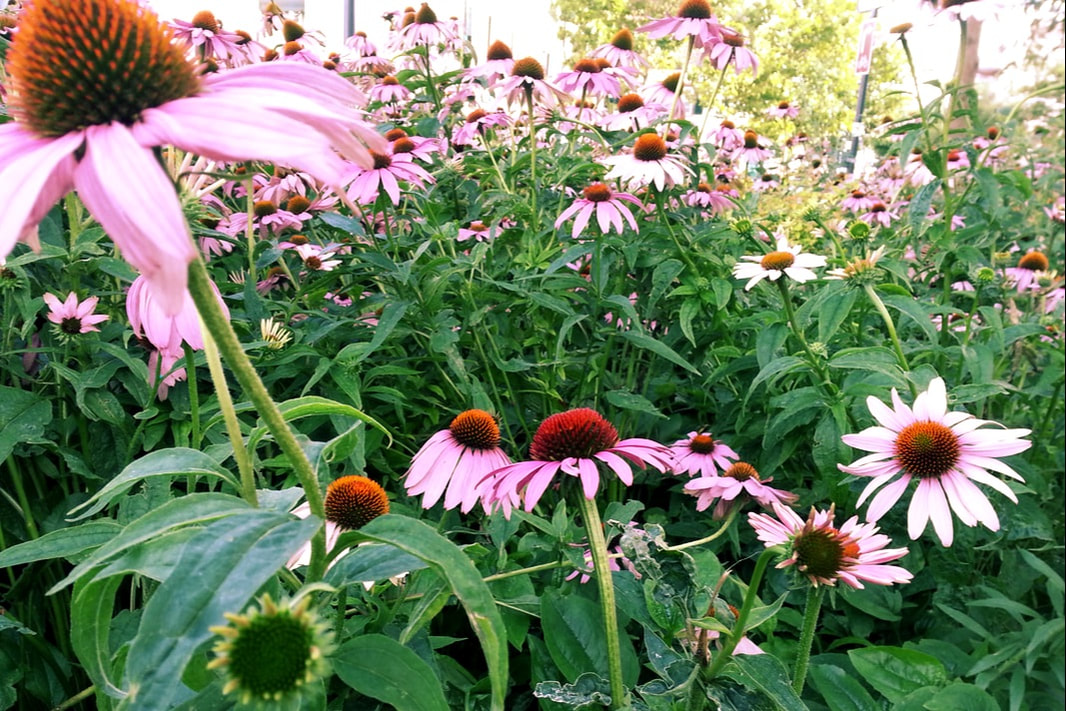
Fast forward 10 years later and I had finished studying Chinese Medicine, became a practitioner, moved to Switzerland and my children have already been born. I wasn't so prone to getting sick but when it came, it would begin with the throat. I knew how to treat it with Chinese herbal formulae but I somehow felt that I needed something simpler, a single herb. I am often aware of my throat, how it feels and the subtle changes that occur before I actually get a cold or flu. I started to experiment on myself, I tried Echinacea tincture on myself, which isn't in the Chinese Materia Medica, by the way. It is now over 10 years that I faithfully carry my Echinacea tincture in my medicine bag when I travel or have it always in my home. My kids have grown up taking the Echinacea tablets when they had a runny nose or when we got on planes, as an immune system strengthener and instead of candy to relieve ear pressure. I have grown Echinacea now in my garden for a few years and finally this year, she is thriving in a pot at my front door, grown from seed. She hasn't been simple to grow since the slugs and snails have feasted on her in my garden every year and she never could survive.
Echinacea purpurea or Purple Coneflower is a native of the Great Plains of North America and is a member of the Asteraceae or Sunflower family. The name Echinacea is Greek, meaning "Spiny One," referring to spiny sea urchins and purpurea to the reddish-purple color. There are a few other species of Echinacea some have yellow or white petals, E. purpurea, E. augustifolia and E. pallida are the ones used in medicine. She, I experience her as female, is a hardy plant, with a beautiful orange-yellow-green spikey cone-shaped head in the center and a skirt of light-purple petals. Amazingly beautiful! Sometimes when I stare into the cones from above, I get a trip, observing the formation of the spikes that form the cone - spiraling clockwise, anti-clockwise in never-ending complexity inward and outward. She attracts bees and butterflies (and slugs too!). Like many perennials, she blossoms only from the second year on, if planted from seed, from July to September.
The part of the plant that is often used for medicine is the root but all parts are used. As I stated before in other posts, Chinese Medicine categorizes food and medicine by temperature, tastes, organs it affects and functions. Echinacea has a cool temperature, with spicy, bitter and slightly sweet tastes. She affects the Lungs but I have found some sources that also state that she affects the Liver, Urinary Bladder and Stomach. She helps to clear Wind-Heat (TCM diagnosis for some colds and flus) and Lung Heat, where the heat has passed deeper into the Lung manifesting bronchitis symptoms like fever and yellowish nasal secretions or cough with yellow-green phlegm. I have never tried her for Bladder themes or insect/snake-bites but she has been documented to be used by the Native Americans of the Great Plains, like the Cheyenne, Kiowa and Lakota Sioux, for various ailments for over hundreds of years.
It is my experience that Echinacea should be used as an individual herb only in acute situations for a short period of time, about 3 but no more than 10 days, at least 3 times a day. I have heard experiences of patients, who used Echinacea daily for over 2 years and found that it wasn't effective anymore. I can understand this; it's like overusing any substance over an extended period of time will reduce its effectiveness for acute issues. Use of Echinacea over a longer period of time should be in combination with other herbs, such as with other Wei Qi (Defensive Qi) tonics, in order to strengthen the immune system.
Echinacea has been my doorway-opener into Western herbs. Literally, she helps me protect my body's doorways, my throat and Lungs from invasion from bacteria and viruses. Lots of scientific research is being done on Echinacea in this field. As with all herbs and with nature, use with respect and honor them. They will respond to us as we to them.
Images by Elaine


 RSS Feed
RSS Feed